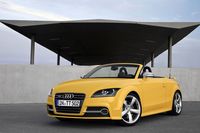Special Edition TTS Competition Celebrates 500,000 Audi TTs
INGOLSTADT, GERMANY – Aug 16, 2013: Audi is celebrating production of the 500,000th TT with an exclusive special edition model. Coupé and Roadster versions of the 200 kW Audi TTS competition – painted in either Imola Yellow or Nimbus Grey – will begin rolling off the assembly line in October. Total production is limited to 500 units.
The TT has long been a design icon, and Audi is enhancing this classic sports car with two exclusive paint finishes: Imola Yellow or Nimbus Grey, along with a fixed rear wing with matt aluminium-look struts. The Roadster’s cover is available in either black or grey. The 19-inch wheels feature a five-arm “Rotor” design.
The Impulse leather package in steel grey dominates the interior of the TTS competition. The edges of the leather are dyed Imola yellow, and this same shade of yellow is used for the contrasting stitching. Aluminium badges on the door trims embossed with “1 of 500” accentuate the exclusivity of this special edition. Additional features like a contoured leather steering wheel and the rear parking system complement the generous list of equipment already standard on the TTS.
With its 200 kW and 350 Nm of torque, the 2.0 TFSI engine defines the dynamic character of the Audi TTS competition. quattro permanent all-while drive delivers the power to the road, and top speed is electronically limited to 250 km/h.
Paired with the six-speed S tronic, the Coupé accelerates from 0 to 100 km/h in 5.3 seconds (5.5 seconds with manual transmission). Average fuel consumption is 7.7 litres per 100 kilometres with the S tronic, 7.9 litres per 100 kilometres with the manual.
The Audi TTS competition Roadster with the six-speed S tronic sprints from 0 to 100 km/h in 5.5 seconds. With the manual transmission, this same sprint takes 5.7 seconds. The Roadster consumes 7.9 litres of fuel per 100 kilometres when equipped with the S tronic and 8.1 litres per 100 kilometres with the manual.
Audi Australia will gauge customer interest in the TTS competition model before any decision is made to secure a limited number for the local market.
A short history of the Audi TT
The production of the 500,000th
Audi TT documents the success of the compact sports car. The TT achieved
design icon status with the very first generation, which debuted as a Coupé
in 1998 and as a Roadster the year after. Its consistently implemented
clarity of form and the loving attention to detail continues to captivate
both the media and customers alike.
As a Coupé, the compact sports car impressed with its 2+2 seating concept and variable luggage compartment; as a Roadster with its puristic, lightweight cloth top. It set standards with its technology: with the potent downsizing turbocharged engines, quattro all-wheel drive for the high-end models and with the six-speed S tronic, which debuted in the model series in 2003.
The second generation, which followed in 2006/2007, marked the first time that Audi succeeded in reversing the weight spiral. The ASF (Audi Space Frame) body, which is made predominately of aluminium, made the new version as much as 90 kilograms lighter than the previous model. The low weight enables strong performance with very low fuel consumption. Another Audi innovation was the TT 2.0 TDI quattro: the world’s first premium-segment sports car with a powerful diesel engine and all-wheel drive.



